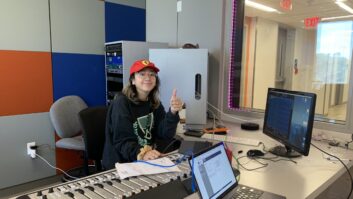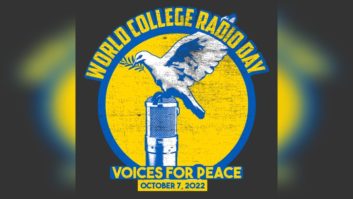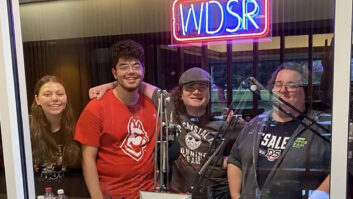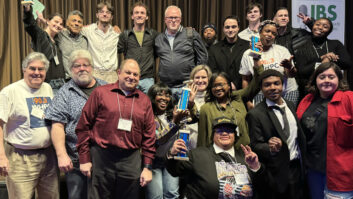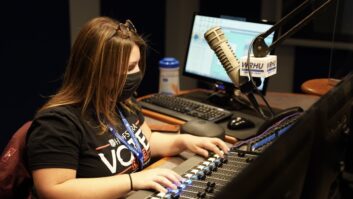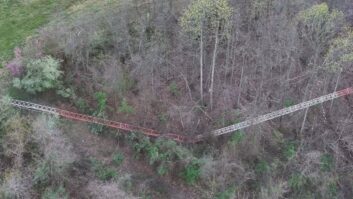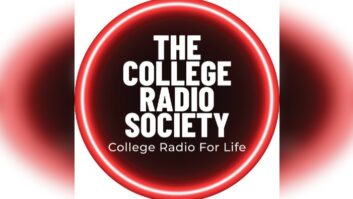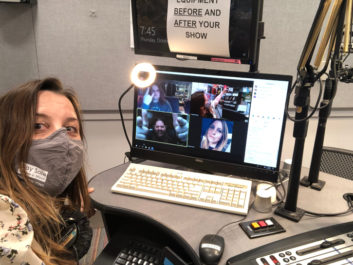
The Montclair State University students at college radio station WMSC(FM) 90.3 MHz have proven that limitations created by the current pandemic will not keep them from getting back to the business of radio. In fact, they were pretty busy on the evening of the recent presidential election. Radio World spoke with Anabella Poland, general manager of WMSC at Montclair State University about the radio station and program available to the students.
Radio World: Please describe your media operations, including the physical plant. How many studios, and how are they equipped? Where is the transmission facility? How is it equipped?
Anabella Poland: There are three studios, as well as performance space and control room. There is also a Foley studio, which students have used to create radio dramas. The station is located on the second floor of the School of Communication and Media at Montclair State University Montclair, N.J. You can take a quick tour of the facilities here.
The studios are equipped with Axia Element boards with 12 POTS line bridge; Comrex Access codecs; Electro-Voice RE20 microphones; Sony MDR 7506 headphones; VoxPro workstations, Nautel transmitter; Telos Z/IP One; and Telos Zephyr ISDN codecs. Software includes: RCS NexGen automation and music library; Pro Tools, Hindenburg and Audition; VPN access to remote into the station; and StreamGuys streaming services for ACC and MP3 streams.
[Read: College Media Spotlight: University of Nebraska, Omaha]
RW: Who makes the executive decisions for the station? What role do the students have in station operations? What types of programming do they produce?
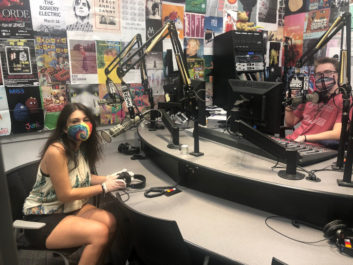
Poland: As the general manager, I oversee the station’s budget and make executive decisions. The station is not under the student government association but within the School of Communication and Media.
The student management team consists of 11 directors in the roles of station manager, program director, news director, sports director, music director, production director, engineer, digital marketing director, web director, business director/office manager and morning show producer. Most directors also have an assistant. These leadership roles are designed to train students and give them an opportunity to work in a real-world situation giving them room to explore, discover and learn. The student directors make decisions about programming, promotional activities, award submissions, staff and show scheduling. The format is alt-rock and talk, but we also have a few specialty shows (metal, classic rock, Broadway and standards).
RW: Are students on campus now or learning and operating remotely?
Poland: Currently, the radio station is operating in a hybrid, high-flex modality, with some students on campus and some students operating remotely.
Students who work on news and sports shows have access to the live studio as their programming has a short shelf life, while all other programming is prerecorded and scheduled for air. There is a limit of two students max in-studio at any given time; masks are mandatory; and we set strict sanitation guidelines that include disposable headphone covers, vinyl gloves, sanitizer and disinfectant wipes for electronics. Newscasters, sportscasters, contributors and guests connect to the station for live shows via Zoom.
RW: Is the station currently on the air? What means and products (software or hardware) are being used?
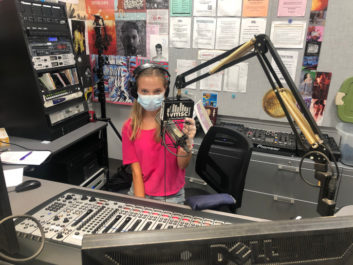
Poland: Yes, the station is on air and has been on air since March 23. During the stay at home orders, we used VPN to remote into the station for live shows without needing a board op in-studio, and we used Zoom to connect with students at home to take them to air.
Once the fall semester began, we transitioned to live, in-studio board ops for live shows to free up resources that took us to air for the previous five-plus months, but also because students were eager to be back in-studio.
For live shows we use Zoom. For recorded shows, students use Cleanfeed, Discord and Zoom. For podcasting, we use Zoom and Cleanfeed, but students can also reserve the production studio for which they must follow COVID-19 protocol and guidelines. Students working remotely use a variety of USB microphones such as the BLUE Snowball and Yeti microphones and a variety of gaming headphones.
Recent example of live programming: This link takes you to the five-plus hours Election Night show, which was also live on the station’s YouTube page. The two hosts were in-studio and the contributors and guests joined over Zoom. The broadcast included prerecorded and live interviews with experts in the field of politics, education, communication and economics. The show also featured reports from student reporters at sister stations located in battleground states: Pennsylvania (Neumann University), Wisconsin (University of Wisconsin-Madison), Michigan (Michigan State University) as well as a student reporter from sister station in Sweden (K103 Goteborgs) and a student from sister station in Texas (University of Texas Arlington).
RW: What impact has COVID-19 had on the station? Challenges due to social distancing?
Poland: The greatest challenge is that prior to COVID-19, the station did all its shows live and there was not a system or even the infrastructure in place to upload recorded shows. Doing radio became significantly more cumbersome especially for the programming team in charge of reviewing all recorded shows for content and quality but also uploading and scheduling. This procedure taxed our time exponentially. This modality also entailed training DJs on producing recorded shows, and some of them did not have any audio editing experience. The program and engineering directors put together quick video tutorials to guide everyone. That said, occasionally we get shows that need to be treated by our production team, an area that can quickly become a bottleneck operation.
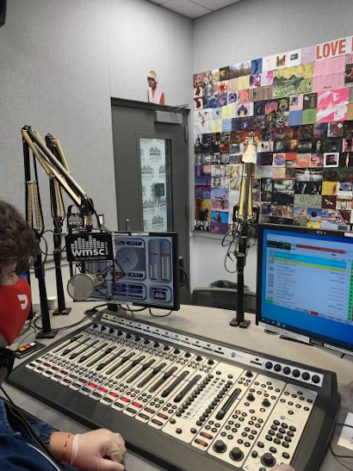
RW: If the students are operating remotely, how are you making that happen? Can you give examples?
Poland: Specific example: The morning show “The Morning Buzz” pre-COVID-19 gathered five students in the studio (co-hosts, newscaster, sportscaster and contributor) During stay-at-home orders, we connected everyone from home via Zoom and then we connected into the station via VPN. Students at first used gaming headphones to do radio and they slowly transitioned to USB microphones (BLUE Snowball Black Ice, Yeti, etc.). This changed with the fall semester, and now a student board op is in the studio for live shows, and uses Zoom to connect to co-hosts, contributors, producers, etc.
We created a virtual radio station on Discord mirroring the quantity of physical space at our station, and “hired” a Discord bot to assist with recordings over Discord voice channels. The bot is summoned to the virtual studio with a written command and records multitrack/multichannel recordings. Once the recording is done, the bot provides a link with the recording for download.
Student management meetings, general meeting and team building activities take place via Zoom and Discord server. We use Google Suite for collaborating on scripts, show schedules, surveys, prerecorded shows logs, etc. We collaborate on Canvas for digital marketing efforts. Students exploited the video capabilities of Zoom taking live video to our social media pages.
RW: Is there anything else our readers should know?
Poland: The day N.J. Gov. Phil Murphy announced restrictions due to COVID-19, we were at a collegiate broadcasters’ conference in New York City and we had just visited SiriusXM headquarters where I was director of talent and industry relations between 2008 and 2015. To say the students were on Cloud Nine would be an understatement. The mood quickly soured that evening when, upon hearing the news, I made the decision we would not be going to the second day of the conference the next day. Although we had a dozen award nominations and were scheduled to present at the conference the next day, the risk was simply too high. Instead, we met at the radio station and offered the presentation over our Instagram Live.
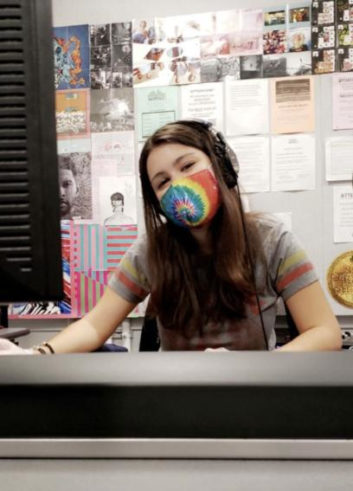
We headed into an extended Spring Break (two weeks). On the first couple of days of the second week of Spring break, it became apparent students were experiencing high levels of anxiety caused by the uncertainty of the pandemic. Many lost their jobs on campus. Some had their parents lose their jobs. Although the station could have continued in automation, I felt it was imperative and natural to provide a link back to campus and to one of the activities they love the most, radio.
I spoke to Chief Engineer of Broadcast and Media Operations Adam Goldberg and I asked: “What can we do?” Within a week we had a plan and the necessary software to take students to air. The ability to stay engaged and continue broadcasting has been quoted by several of the DJs and directors as the “true north” in the midst of so much chaos and many unknowns.
WMSC was nominated for the prestigious Marconi award twice in the last four years: In 2017 for Best Non-Commercial Station of the Year and 2019 for Best College Radio Station of the Year.





